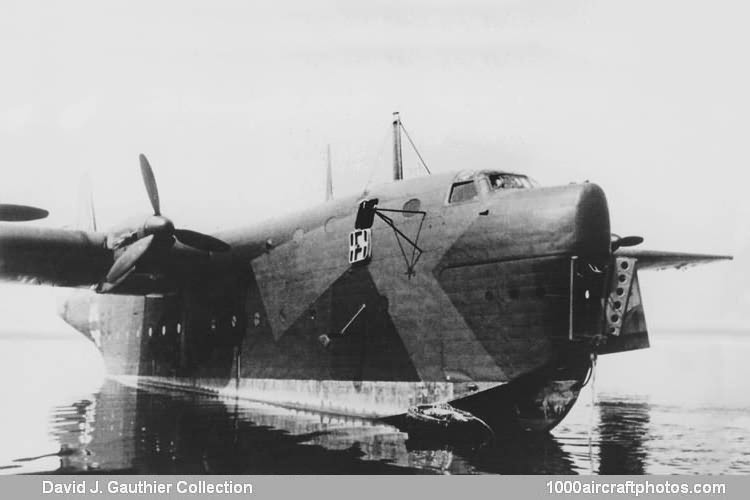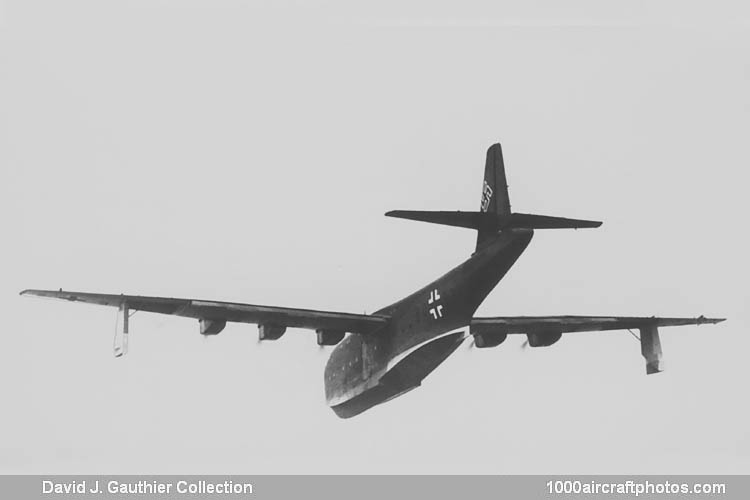07/31/2011. Remarks by Johan Visschedijk: "In January 1941, Blohm & Voss received instructions from the RLM to prepare a project for an extremely large multi-purpose flying boat powered by four 2,500 hp Junkers Jumo 223 diesel engines. Envisaged as an ultimate replacement for the BV 138, the project was allocated the designation BV 238, and within a month the basic layout had been submitted to the RLM.
In July 1941, it became obvious that Junkers would be unable to bring the Jumo 223 engine to production status for several years, and Blohm & Voss were forced, therefore, to abandon the original BV 238 project and produce an entirely new design. Of similar basic concept to the earlier BV 222, the second BV 238 proposal was for a large six-engined aircraft of orthodox configuration powered by either the Daimler-Benz DB 603 V twelve-cylinder liquid-cooled inverted V-engines or the BMW 801 air-cooled radial.
A development order was promptly placed to cover the construction of four prototypes, the first three of these, the BV 238 V1, V2 and V3, having the liquid-cooled engines and serving as prototypes for the BV 238A production model, and the BV 238 V4 having the air-cooled radials as a prototype for the proposed BV 238B.
The design of the BV 238 incorporated the latest German hydrodynamic discoveries, and in order to gain some idea of the handling characteristics of the boat, it was decided to build a flying scale model to approximately quarter-scale. The construction of this model was entrusted to the Flugtechnische Fertigungsgemeinschaft Prag (Aeronautical Manufacturing Corporation Prague), a small factory in the vicinity of Prague, Czechoslovakia, which had some experience of wooden glider manufacture.
Work on the model, which was designated FG-227, began in 1942. The aircraft was of wooden construction and powered by six 21 hp ILO F 12/400 two-stroke engines. It was anticipated that construction of the model would be completed within twelve months but, in the event, it was not until early 1944 that the FG-227 was ready for testing.
While being loaded aboard a train which was to transport it to Travemünde the model was sabotaged, and the damage was not repaired until September 1944. On its first test flight a fault in the fuel supply resulted in the stoppage of all six engines, and further damage was sustained when the machine was forced to alight on the sea. Thus, the FG-227 played little part in the development of the full-scale BV 238.
Work on prototype construction had begun with the receipt of the development order from the RLM, and owing to Blohm und Voss's limited design capacity, a second design bureau for BV 238 development was established in Paris, and the Weserflug concern was also instructed to participate in the design program. It was intended that the BV 238 would be used for the long-range reconnaissance, bomber and armed transport roles.
The reconnaissance and bomber variants were to have carried a defensive armament of twelve 0.787 in (20 mm) MG 151 cannon in six twin-gun barbettes, most of which were to be remotely-controlled, and the transport version was to have had one barbette immediately aft of the flight deck and another in the tail. The remotely-controlled lateral barbettes were abandoned at an early stage, owing to their weight and complexity, these being supplanted by hand-held 0.512 in (13 mm) MG 131 machine guns or 0.787 in (20 mm) MG 151 cannon firing through sliding panels.
In the spring of 1943, further changes in the proposed defensive armament took place, this being standardized as four MG 131 machine guns with 7,200 rounds in a manned nose turret, a similar turret in the tail, twin MG 151 guns with 2,800 rounds in a turret immediately aft of the flight deck, a turret with four MG 131s and 3,600 rounds at the extremities of the wing center section, and two MG 131s with 1,000 rounds per gun firing through beam windows.
In order to accommodate the wing-mounted four-gun turrets, a special component had to be built into each end of the wing center section, necessitating the reinforcement of the main spar and an increase in wing span and area, and increase of the empty weight. Tank tests indicated that the increased span would result in a reduction in the flying boat's ability to withstand operations from rough water, and further strengthening was undertaken, further increasing the empty weight.
The BV 238 V1 began trials in the early spring of 1944, and it was planned that armament would be installed after the completion of flight testing, but before this plan could be carried out, the flying boat was destroyed in a strafing attack on Lake Schaal (Northern Germany) by USAAF Mustangs.
The BV 238 V2 was nearing completion at the end of the war, and construction of the BV 238 V3 was well advanced."

